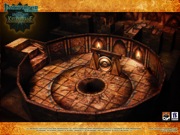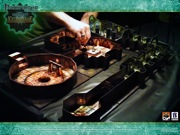This 64-page adventure is designed for heroic characters of 4th through 6th level. The adventure is densely packed with combat, roleplaying, stealth and trap finding encounters. Curse of the Kingspire is sure to please experienced players as they struggle to rise above the challenges, and fill game masters with evil glee at the same time. If you are looking for a challenging adventure that rewards thinking and creative play, then M2: Curse of the Kingspire is exactly sort of product you should be picking up.The remainder of this review will discuss details of the plot. Consider yourself warned.
The adventure involves the characters’ investigation of a ruined Eladrin fortress. Those gamers familiar with Dungeons and Dragons: Fourth Edition should recognize the Eladrin as one of the new player races detailed in the Player’s Handbook. The race’s name comes from the Planescape setting of Second Edition, though these Eladrin are a reinvention of the concept. In Fourth Edition, they are a more fey-like elven race, roughly equivalent to High Elves from earlier editions - graceful, aloof, and detached from mortal concerns. It is suggested that the players could be attracted to the adventure site by the lure of lost lore, the hunt for a fabled artifact, or desire to disrupt a dangerous new cult. Regardless of the hook to bring the party of characters to the Kingspire, there is considerable adventure for them to experience.
The start of the adventure involves the PCs becoming aware of the threat of the cult inhabiting the spire. This area is designed for infiltration, with the PCs having opportunities to negotiate, bluff or sneak their way past opponents to reach the cult leader at the height of a ritual to reunite the Eladrin court with the material plane. Even though all opponents have been provided with combat statistics, there is no assumption that all encounters will degrade into combat, and several are more difficult if the heroes resort to violence first. At the end of this section the PCs will have infiltrated the hamlet near the Kingspire, fought voracious undead, and interrupted a magical ritual that sweeps them into a prison demiplane of the Kingspire’s last night.
Experience as a gamemaster is definitely needed in the second section of the adventure, as the players become caught within a time loop, reliving the final thirteen hours of the Kingspire’s final night. In this section there are a number of time sensitive encounters that activate if the characters are in the right place at the right time. This area will require careful roleplaying to avoid the pitfalls of a decadent Eladrin court while struggling for a means to escape the demiplane.
The final section involves the PCs descending into the catacombs of the Kingspire to find a way to end their imprisonment in the demiplane. This section is more straightforward, with brute force working very well for most areas, with the exception of the final encounter with the Devourer Worm. Once the heroes have recovered the artifact that can free them from the demiplane prison, the best approach to dealing with the Devourer Worm is to run like hell and hope you run faster than the slowest guy in the party. Strangely the worm has a bite that grabs, but no special attack on a held grab.
There is definitely an “old school” feel to this adventure. There are some extremely tricky traps, such as in the torture chamber. In this encounter, the first PC to see the iron maiden may be psychically linked to the spirit of a half-elf killed in the far past. They begin to bleed out until they are removed from the room or the iron maiden is opened (there is no option for saving to ends the effect). Once open, the ceiling above the maiden begins to collapse while the corpse of its victim tries to grab the PC who opened the iron maiden. If the grab is successful, the ceiling automatically hits.
There are some potentially devastating encounters, such as when the PCs try to cross the swamp only to be attacked by swamp zombies. If the zombies are successful at getting several hands on the raft, they overturn it, sending the heroes into the swamp with the intent of drowning them. There are powerful magic items that are both boon and bane, such as a magic orb allowed you to reset a daily power at the loss of heroic surges (possibly permanently), or a magical artifact that is liable to consume your PC in the long run. There are some plot fiats that constrain the story at key points - the magical ritual that the PCs arrive to prevent cannot be stopped, so as soon as they enter the ruined Kingspire they will be drawn into the demiplane and become trapped. This is tricky, because if the hook you used to draw the PCs to the adventure was to disrupt the cult, this fiat will likely make them feel ripped off that they had no control over the outcome. This is something that needs careful consideration before your players reach this point. My suggestion would be to use one of the other hooks to avoid this potential disappointment.
This module is published under the Open Game License instead of the Game System License. As such, the symbols used in the stat blocks are not the same as those that appear in products by Wizards of the Coast. The symbols are similar though and it takes little effort to make the adjustment. The adventure also does not use the “delve” format common to modules by Wizards of the Coast, which results in two significant changes. The first is that encounters do not fall into a strict format, so it will be necessary to prepare for adventure ahead of time. The second change is that by not relying on a rigid encounter format, the author is able to provide us with more encounters in a module of equal length. Anything that results in me getting more adventure for my gaming dollar is fantastic.
As I read through the module, I was initially distracted by a number of editing errors. These were not grammar or spelling, but things that didn’t get adjusted as the module went through internal revision. For example, the opening section says the adventure is for characters of 4th to 6th level, while later on the same page it says 1st to 6th. Or at another point the module text indicates the Miller’s apprentice is in area K-5, but he’s actually in K-6. Occasionally an opponent is misnamed in text and stat block. Once I got past the initial section on the Kingspire Hamlet (section K), the editing improved.
Overall, I really enjoyed Curse of the Kingspire - the adventure provides lots of opportunities for creative and intelligent gaming, with nods to an older style of play. There are opportunities for stealth, skill challenges, and roleplaying as well as combat. I would absolutely recommend this module to anyone looking for a Fourth Edition compatible module packed with challenging encounters. Plus bonus points for Clyde Caldwell cover art.Want to learn more about Master Dungeons? Read on…
Atomic Array: Episode 017: Master Dungeons
Game Cryer: Curse of the Kingspire Review
Gnome Stew: Mastering Goodman’s Dungeons
Musing of the Chatty DM: Curse of the Kingspire Preview
Campaign Mastery: The Plot Thickens - Hooking Players Into Adventure
Drop by Goodman Games to pick up your copy today!







 Thesk straddles the western end of the Golden Way, the trade road that connects far-off Kara-Tur with the main part of Faerûn. Because of this, Thesk is a very wealthy nation and handles a lot of trade. "I want you to go to Two Stars," says the woman seated across from you. "I have a certain property coming in on a caravan from Shou Lung, and I would like to have it 'diverted' from the Golden Way before it reaches Telflamm and gets taxed. All you have to do is meet with a merchant named Beavom Tastald and give him this, and he will give my package into your keeping. Take it south on the Cold Road into Nethentir and meet the Spry Jewel of the Sea. The captain will take it off your hands."
Thesk straddles the western end of the Golden Way, the trade road that connects far-off Kara-Tur with the main part of Faerûn. Because of this, Thesk is a very wealthy nation and handles a lot of trade. "I want you to go to Two Stars," says the woman seated across from you. "I have a certain property coming in on a caravan from Shou Lung, and I would like to have it 'diverted' from the Golden Way before it reaches Telflamm and gets taxed. All you have to do is meet with a merchant named Beavom Tastald and give him this, and he will give my package into your keeping. Take it south on the Cold Road into Nethentir and meet the Spry Jewel of the Sea. The captain will take it off your hands." The land of Darguun is now a rougher place than it was when it was part of Cyre, chiefly because of its new masters. But the Mournland's presence on the northeastern border also contributes, since strange monsters stumble out of that ruined land and lay waste to whatever they find. The goblins at Gorgonhorn do their best to stop these incursions. But others are also concerned.
The land of Darguun is now a rougher place than it was when it was part of Cyre, chiefly because of its new masters. But the Mournland's presence on the northeastern border also contributes, since strange monsters stumble out of that ruined land and lay waste to whatever they find. The goblins at Gorgonhorn do their best to stop these incursions. But others are also concerned. The High Moor and the Serpent Hills are well known for being the haunts of monsters, and both are wisely avoided by the prudent traveler. But danger does not always stay contained. Monsters enlarge their territory or move into new areas when forced.
The High Moor and the Serpent Hills are well known for being the haunts of monsters, and both are wisely avoided by the prudent traveler. But danger does not always stay contained. Monsters enlarge their territory or move into new areas when forced.  Forgotten Realms
Forgotten Realms Eberron
Eberron
 Either in a tavern or on the streets of a town, the PCs cannot help but overhear this snippet of conversation. “We’re the last of the Goldiron clan, and we’re here to find the clan ancestral home,” says the dwarf woman. She acts like the leader of the group. “We think that a branch of our family lives at the citadel; they would be the only relations we still have left in the world.”
Either in a tavern or on the streets of a town, the PCs cannot help but overhear this snippet of conversation. “We’re the last of the Goldiron clan, and we’re here to find the clan ancestral home,” says the dwarf woman. She acts like the leader of the group. “We think that a branch of our family lives at the citadel; they would be the only relations we still have left in the world.”







 I bet you didn’t realize that there were some uber geeks on Facebook. Hasbro got creative on Facebook and their subsidiary Wizards of the Coast, launched the a Facebook version of
I bet you didn’t realize that there were some uber geeks on Facebook. Hasbro got creative on Facebook and their subsidiary Wizards of the Coast, launched the a Facebook version of 